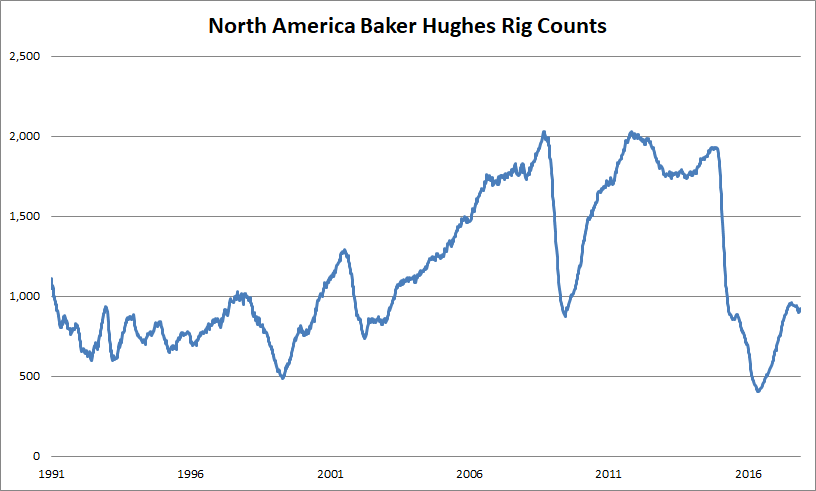The Organisation of Petroleum Exporting Countries (OPEC) is expected to prolong its 1.5 billion barrels per day (bpd) deal until the end of 2018 from currently agreed March of 2018. The move is widely expected and therefore should be of no surprise for the market players. The economic consequences of oil supply cut extension are directly linked with oil producers but are less likely to dramatically affect the behavior of consumers or the actions of central banks.
What is expected from OPEC meeting?
OPEC and its allies hammered by a prolonged period of low oil prices have decided to cut oil production by 1.8 million bpd back in January this year. With the worldwide average demand of nearly 96 million barrels of oil and liquid fuels per day, the OPEC daily supply cut equals to about 1.9% of global daily oil demand, according to estimates from the International Energy Association.
The strategy of cutting the oil supply worked and since then the oil prices are much higher. Higher oil prices were affected not only by organized oil supply cut but also by the fact that other non-OPEC countries like Russia joined the strategy. Originally the deal within OPEC was to cut the oil supply until March 2018. It is now widely expected that 173rd OPEC meeting in Vienna will prolong the oil supply cut until the end of 2018.
There is a dark side to lifting oil prices using supply cut strategy. Higher prices have encouraged greater output among US producers. According to Baker Hughes rig counts report monitoring the US and Canadian drilling activity on weekly basis, the number of rigs rose to 1138 in North America only in the week ending November 22. The US rig counts rose to 923 as of November 22 this year, representing an annual increase of more than 50% and reflecting current oil price surge.
Higher oil prices and inflation
A combination of the OPEC and non-OPEC supply-side cuts has natural constraints and political issues in countries like Libya while "normal" pipeline problems have also helped lift prices elsewhere.
North sea standard Brent rose some 8% this year alone, but compared to late June oil price lows, it is up almost 45%. Light sweet crude rose 20% this year and is up 40% since the mid-year low.
Both measures are expected to feed through into headline CPI measures in months to come, but the extent of oil price “passing through” to inflation is rather unclear.
According to a research paper from the US Federal Reserve Bank of St. Louis, In 2014, the United States used about 6.95 billion barrels of oil at an average price of $93 per barrel. United States used about $648 billion dollars’ worth of oil in 2014, which was about 3.8% of US GDP.
Researchers at Fed also measured the link between the oil prices and inflation and their conclusions indicate the traditional link between oil prices and inflation is becoming muted in a modern economy.
“Fifty percent reduction in oil prices would cumulatively reduce expected CPI inflation by 27 basis points per year, or about 2.7 percentage points, over a horizon of 10 years” St. Louis Fed research paper claims.
One thing is sure, with higher oil prices, inflation will eventually pick up, but even then still can be disregarded by central bankers as a phenomenon out of reach for a monetary policy.
Note: All information on this page is subject to change. The use of this website constitutes acceptance of our user agreement. Please read our privacy policy and legal disclaimer. Opinions expressed at FXstreet.com are those of the individual authors and do not necessarily represent the opinion of FXstreet.com or its management. Risk Disclosure: Trading foreign exchange on margin carries a high level of risk, and may not be suitable for all investors. The high degree of leverage can work against you as well as for you. Before deciding to invest in foreign exchange you should carefully consider your investment objectives, level of experience, and risk appetite. The possibility exists that you could sustain a loss of some or all of your initial investment and therefore you should not invest money that you cannot afford to lose. You should be aware of all the risks associated with foreign exchange trading, and seek advice from an independent financial advisor if you have any doubts.
Recommended Content
Editors’ Picks
EUR/USD hovers around 1.0700 after German IFO data

EUR/USD stays in a consolidation phase at around 1.0700 in the European session on Wednesday. Upbeat IFO sentiment data from Germany helps the Euro hold its ground as market focus shifts to US Durable Goods Orders data.
USD/JPY refreshes 34-year high, attacks 155.00 as intervention risks loom

USD/JPY is renewing a multi-decade high, closing in on 155.00. Traders turn cautious on heightened risks of Japan's FX intervention. Broad US Dollar rebound aids the upside in the major. US Durable Goods data are next on tap.
Gold price trades with mild negative bias, manages to hold above $2,300 ahead of US data

Gold price (XAU/USD) edges lower during the early European session on Wednesday, albeit manages to hold its neck above the $2,300 mark and over a two-week low touched the previous day.
Worldcoin looks set for comeback despite Nvidia’s 22% crash Premium

Worldcoin price is in a better position than last week's and shows signs of a potential comeback. This development occurs amid the sharp decline in the valuation of the popular GPU manufacturer Nvidia.
Three fundamentals for the week: US GDP, BoJ and the Fed's favorite inflation gauge stand out Premium

While it is hard to predict when geopolitical news erupts, the level of tension is lower – allowing for key data to have its say. This week's US figures are set to shape the Federal Reserve's decision next week – and the Bank of Japan may struggle to halt the Yen's deterioration.
